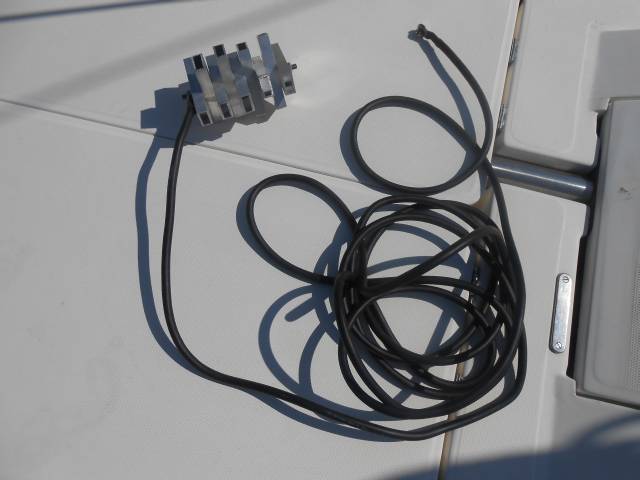Lightning Protection for Catamarans – One Boat’s Solution
Here are the facts:
1) Boats often get struck by lightning and catamarans in particular seem to be more vulnerable that most.
2) Getting struck by lightning is no fun. Most likely it will kill all your electronics. It may put holes in your boat. And if you are really unlucky it may hurt or kill you.
So what can you do to prevent or minimize the danger?
There is much already writing about lightning protection on boats. But, unfortunately, not so much about catamarans.
So, after a discussion about the topic on the Multihulls4Us forum, here is my solution:
1) I bought an aluminium rod, about 16mm in diameter and 150 cm long. I ground down the side on one end to make a flat surface, and then bolted this to the top of the mast. This I did by drilling three holes in the mast, and then tapping a thread that would take a stainless steel bolt. I applied some TefGel to the bolts so as to prevent electrolytic corrosion when I bolted the rod to the side of the mast. The connection between the rod and the mast is far from perfect, but I believe there is enough surface area touching to make a good connection. At least my multi-meter couldn’t detect any resistance between the two.
Note that the rod reaches up at least 18cm higher than my VHF antenna.
2) I bought a length of aluminium box section. This is a rectangular section, 50mm wide by 20mm high, which I cut into lengths approx 18cm long. These were then bolted together by a length of stainless steel threaded rod. This is the lightning dissipator. It is designed like this so as to have a large number of edges. In this case there is at least 2.5 m of edges. The reason for that is that it seems that lightning prefers to exit from edges rather than from a flat surface.
3) I made up a length of 0 gauge (that is big and fat) battery cable, with connectors at each end. One end of this is bolted to the dissipator, making sure there is a good flat connection, with no intervening stainless steel washer or nut, between the cable and the aluminium.
4) I drilled a hole at the base of the mast, but not too low, and then tapped this with thread to accept a fat bolt that would fit the terminal on the cable.
In normal use, the cable and its attached dissipator sit in a convenient locker. If lightning threatens, then I quickly bolt that cable to the bottom of the mast, and drop the dissipator through the anchor hatch into the sea. The reason that the hole in the mast is not too low is to prevent any sharp bends in the cable on its way to the sea.

The cable is bolted to the bottom of the mast, and the dissipator is dropped through the anchor hatch into the sea.
That’s it.
The theory is that I now have a low-resistance route directly from above my VHF antenna to the sea. That should prevent the lightning from finding other routes to the sea, such as through my wiring etc. Of course I hope to never actually put that theory to the test.
Some additional thoughts on this setup:
1) Using a stainless bolt to join the aluminium sections together is not ideal. There will be galvanic corrosion that occurs between the two metals. However, I am not relying on the steel to conduct the electricity, as there is a a good flat connection between each of the aluminium pieces. A better solution would be to have an aluminum threaded rod made up – or even to weld the aluminium pieces together. Having said that, the unit is only in the water when a storm threatens. The rest of the time it is in a dry locker. The same point also applies to the connection between the copper cable terminal, and the aluminium, though not, I believe, to the same extent.
2) Life Part 2 has synthetic shrouds, so that is unlikely to provide a good path for the lightning. But we do have a stainless steel forestay. I am contemplating doing the same setup from the bottom of the forestay into the water. However, even if the current does flow down the forestay, it seems to me there isn’t really anywhere for it to go, at least anywhere that would cause much harm, other than back down the middle to the anchor chain, where it would meet my existing cable setup. So maybe another cable would be superfluous.
If I had steel shrouds, then I think I would bond together all the shrouds and the forestay, and then earth the forestay with a dissipator and cable. The shrouds could all be bonded together by connecting the toerails and lifelines together as a big ring around the boat. That might even give a bit of a Faraday cage effect too.
3) My mast still has wires coming out the bottom of it which go into my electronics etc. I am thinking of putting a quick plug and socket connector (like an automotive wiring loom system) so that I can quickly physically disconnect and isolate the wiring in the mast from the rest of the boat.
4) Laptops, hand-held GPS etc still go in the oven for protection, as that provides a Faraday cage too.
5) If lightning threatens, bolt the cable to the mast early on, as going outside when lightning is REALLY threatening is not a good idea!








My catamaran is in Florida and I plan on cruising the Bahamas, so I’m concerned about lightning strikes. This article about lightning protection for catamarans is very informative, but I’m curious about step one of your solution.
Seems to me, by attaching the aluminum rod at the top of the mast screams “HIT ME – HIT ME!!”. If you did everything else that you recommended, wouldn’t you still have disbursement into the water if the mast were struck?
Thanks,
Carole
Your mast, sticking up 60ft into the air is already screaming ‘Hit Me’. The goal here is that if you do get hit, it goes right down the mast and then right into the water instead of finding an alternative route through your hull and your electronics. No guarantees that it will work, of course, and the whole issue of lightning strike prevention is still hotly debated.
BTW, do make sure that your rod at the top is very securely attached and has no weak points in it (such as holes drilled through it) that might fail as a result of constant flexing and work-hardening up there. Alternatively, as you suggest, you could skip the rod and hope the lightning goes directly to your mast and not to your VHF aerial.
Good luck!
Noel